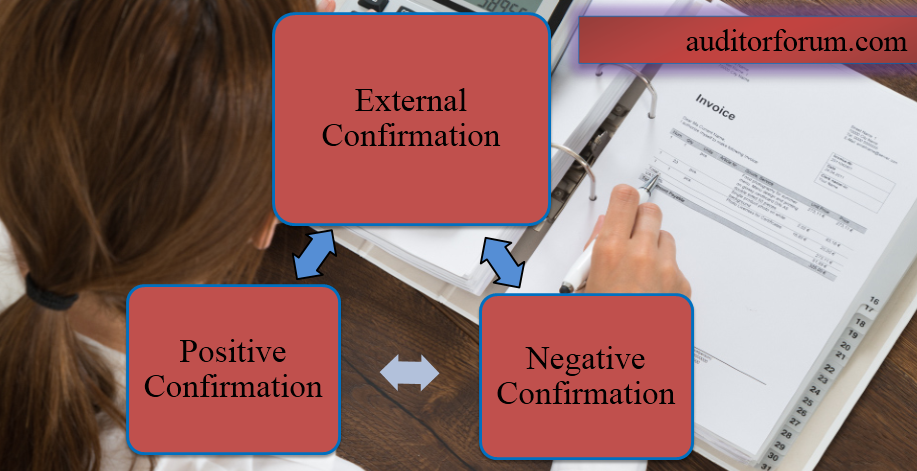Negative External Confirmation
Discuss when it is appropriate to use the negative external confirmation procedure for the purpose of external Confirmation.
Certain conditions are required to be met before an auditor can decide to use negative confirmation as a sole substantive procedure, these conditions include:
- The auditor has assessed the risk of material misstatement as low and has obtained sufficient appropriate audit evidence regarding the operating effectiveness of controls relevant to the assertions;
- The population of items subject to negative confirmation procedure comprises a large number of small, homogeneous account balances, transactions or conditions;
- A very low exception rate is expected; and
- The auditor is not aware of circumstances or conditions that would cause recipients of negative confirmation requests to disregard such requests.
Case Study
The audit of SPL is in progress. Based on the previous experience with the client and the initial tests of control, the auditor has assessed a low risk of material misstatement in the area of debtors.
The debtors’ circularization summary depicts the following information:
| Customer Segment | No. of customers | Balance outstanding | Confirmations sent | Amount covered | Nature of confirmations | Confirmations received | ||
| ———————————- Rs. in ‘000 ———————————- | ||||||||
| Distributors | 12 | 75,200 | 8 | 70,500 | Positive | 7 | ||
| Wholesalers | 105 | 52,500 | 30 | 12,500 | Positive | 28 | ||
| Hospitals and clinics | 250 | 31,200 | 75 | 20,300 | Negative | 4
|
||
| Retailers | 130 | 12,500 | 50 | 7,000 | Negative | 12 | ||
Analysis of confirmations received is as follows:
- 3 out of 7 confirmations received from distributors did not agree with the amount outstanding in SPL’s ledger.
- One of the distributors, (SDPL) has gone into winding up. The balance receivable from SDPL is outstanding since last one year.
- Replies received from the hospitals did not agree with the balance outstanding in SPL’s records. However, the differences were reconciled by the audit staff.
- All the 12 confirmations received from the retailers showed disagreement with the records of SPL. However, only 2 could be reconciled.
(a) Evaluate the decision regarding sending of negative confirmations.
(b) Determine the course of action the auditor should consider in case of balances agreed, balances not agreed and replies not received.
(c) State the procedures that need to be performed in case of amount due from SPL.
(a) (i) Hospitals and clinics:
The decision to send negative external confirmation was appropriate as all the conditions for sending negative confirmation i.e. Large number of small account balances, low risk of material misstatement, low exception rate as only four customers have disagreed with the balances due and that have been also reconciled and there was no knowledge of circumstances that would cause recipient to disregard the confirmation request.
(ii) Retailers:
Results of confirmations depict high risk of material misstatement and high exception rate. However, since the decision to send negative confirmation was taken on the basis of initial assessment, the decision under the circumstances seems correct.
(b) Balance agreed: No further audit work is required.
Balance not agreed: In this case:
- The client should be asked to review the replies and reconcile the balances in its records with the balances confirmed by the customer.
- The reconciliation prepared by the client should be checked.
- The reconciling items depicting errors in the client’s records should be investigated and corrected.
- The client should be asked to resolve the difference in case the reconciling items depicting errors on part of the customers.
No reply received: In these cases, alternative procedures should be performed (e.g. subsequent payments and checking of invoices/ dispatch notes in order to obtain evidence to confirm the customer’s balances.
(c) From the winding up event it appears that the amount receivable from SDPL is irrecoverable.
Therefore, the auditor needs to ensure that the amount of irrecoverable receivables are written off or is duly provided for.The following substantive procedures should also be performed:
- Review any correspondence of the SPL with the liquidator/management of SDPL (if any), relating to recovery of the amount due.
- Review the calculation of amount of provision/write off and basis thereof.
For more external confirmation case study keep visiting auditorforum.com. External confirmation is discussed at Auditorforum.com in detail in further posts.We are keen to know your feedback.








